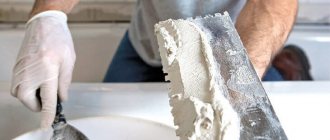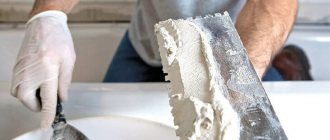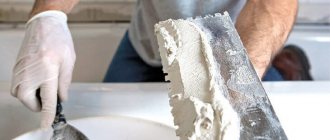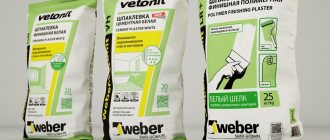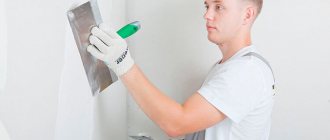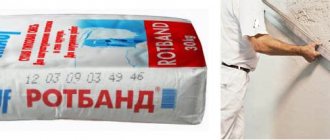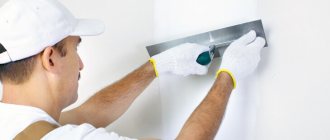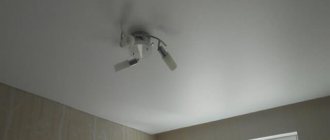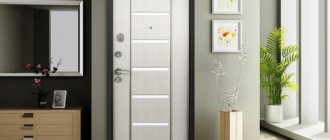| Place | Name | Characteristics in the rating |
| The best starting putties |
| 1 | Rusean TT | The most flexible |
| 2 | Founds Ekonsilk | The best domestic putty |
| 3 | Volma Standard | The most versatile starting putty |
| 4 | Bergauf Glatte Zement | For dry and wet areas |
| 5 | GLIMS Styro Prime | Polymer base. Ease of application |
| The best finishing putties |
| 1 | Sheetrock SuperFinish | The best ready-made putty |
| 2 | Weber LR+ | Whitest surface |
| 3 | Prospectors finishing | Best price |
| 4 | Ceresit CT 225 | The most reliable layer |
| 5 | KNAUF Multi-Finish | Ease of application |
| The best universal putties |
| 1 | KNAUF Fugen | The best universal putty for interior work |
| 2 | VGT acrylic universal | The most convenient putty to use |
| 3 | Unis Blik | Best price |
| 4 | White House | The most durable material |
| 5 | Litokol Litofinish Facade | Economical consumption. Good frost resistance |
When carrying out modern puttying work, special materials are used. The market offers a huge selection of both dry mixtures and ready-to-use solutions. There are cement, epoxy, latex, polyester and other putties designed for application to various substrates.
Our review presents the best mixtures from various manufacturers. For the convenience of the reader, the product ratings were divided into finishing, starting and universal mixtures. The evaluation position is based on the characteristics of the product and the opinion of professional builders who have experience working with this material.
The best universal putties
The advantage of universal putties is the possibility of high-quality leveling. Such compositions are used in preparation for painting or pasting relatively smooth walls. Here are some good all-purpose blends.
KNAUF-Fugen
Rating: 4.9
The KNAUF-Fugen universal putty has proven itself well in heated rooms. The manufacturer added polymer additives to the gypsum powder, which make the mixture elastic. Experts note the high adhesion of the material; the putty holds well on concrete and plastered substrates. The composition has an affordable price and economical consumption. So, when applying a layer of 1 mm, only 0.8 kg/sq.m. is consumed. m of mixture. Experts also highly appreciated the quality of the putty; the grain size (0.15 mm) is lower than that of its closest competitors.
Due to the hygroscopicity of gypsum, it is not recommended to use putty in bathtubs. Despite some limitations, the composition becomes the winner of our rating. The resulting surface dries without side effects (shrinkage, cracking).
Advantages
- economical consumption;
- versatility;
- excellent adhesion;
- elastic layer;
Flaws
- not detected.
Types and characteristics
First, let's look at the types and types of putty for walls. It was indicated above that it is possible to separate them according to the base material. Let's take a closer look at their properties.
Gypsum - characterized by rich color and plasticity. Very convenient to use. Excellent application, processing and sanding. Gypsum has a distinctive feature. It can absorb excess moisture from the air in the room, and when it dries out, return it again. This ensures the maintenance of a comfortable microclimate.
Cement - a type of putty for internal and external processing. Mainly used for finishing untreated brick and concrete substrates. Moisture-resistant material. Can be used for rooms with moisture (bathtub). In addition, it perfectly withstands low temperatures.
Polymer mixtures during the final stage of work. Can be used to seal seams and cracks.
Universal - dry putty, characterized by a significant level of strength compared to others. After application, the surface turns out to be white or gray without visual imperfections. It does not crumble during use and can be easily sanded.
Finishing – compositions used in final finishing. They eliminate the smallest defects and scratches. 1 mm is applied to the base. Any type of finishing putty for leveling is applied in several stages. However, the previous layer must be dried before applying the next one. It is important to maintain the required thickness. Otherwise it will crack. Does not require further processing. Upon hardening, a white silky structure is formed.
Waterproof - these wall putty materials are used for external and internal use. Any type of base can be processed: cement, concrete or already plastered. It has a high level of resistance to moisture.
In addition to the main types, other, more specific types are also produced.
Adhesive – included 10% drying oil, glue and chalk elements. Due to this, it has a strong structure and is perfectly distributed.
Oil-adhesive – additional components are also included: acrylates, drying oil, plasticizer. The choice of putty for walls of this type is determined by the presence of a wooden and concrete base. Possible for those already plastered for subsequent painting or for wallpaper. For internal use only.
Latex - the composition includes acrylates, plasticizers, and calcite additives. Used in the same way as the previous option. Also only for internal processing.
Acrylic universal - made from chemical components. After hardening, a fine-grained surface is obtained. The qualities of leveling compounds have been combined. Good for sanding. After hardening, no cracking occurs. Refers to the safest materials. It is used in interior finishing when processing almost any substrate. Application of any thickness is allowed.
Facade acrylic – has increased moisture resistance. For concrete, wood and plastered exterior areas. Does not crack, increased strength. It sands well and dries quickly. Highly flexible and abrasion resistant.
Oil - during production additives are included - drier, chalk. Used when working with window, door slopes and similar surfaces with increased humidity. Intended as a basis for the subsequent application of oil and water-emulsion paints.
Shakril – for plastered bases and baseboards. Periodically used for laying ceramic tiles in dry rooms. Can be used as a whitewash with a brush after diluting with water.
Putties by degree of readiness
Based on this parameter, there are 2 types of wall putties: dry mixtures and ready-to-use. They are different, so let’s look at their features in more detail.
Dry
They look like ingredients collected in the right proportions. The solution itself is prepared before the start of construction work. These types of putties are sold in bags, which indicate the expiration date and preparation instructions.
Most often, dry mixtures are used in puttying work. To obtain high-quality putty material, you should strictly follow the preparation instructions and adhere to the proportions of components and water. When working with a large area, it is not recommended to immediately prepare a large volume of the mixture. This is explained by the fact that after a certain time the plastic properties of the composition are lost, and it begins to “set.” It is recommended to do several batches.
Attention! When choosing dry mixes, pay attention to the price, because to finish a 3-room apartment you will need more than 1 bag.
There are practically no disadvantages, except that the dry powder leaves behind dust, the mixture itself does not retain its properties for long after kneading and requires clear proportions when preparing.
Putties, ready for use
The convenience here is that they do not need to be prepared - they are already ready, for which special factory technologies are used. An additional advantage is that, compared to dry mixtures, they do not lose their properties after a certain time. If necessary, a break is simply taken during the work, and the container in which the mixture is stored is closed. Thanks to the component that prevents the mixture from setting, it retains its properties for a long time. First, apply the first layer, after it has dried, apply the second, finishing putty. The only thing is that the cost of ready-made mixtures is higher compared to dry ones, but in the process you won’t have to deal with dust and dirt.
It is better to knead with a special mixer
Useful tips for correct puttying
It is not enough to choose a putty suitable for use under wallpaper - it is also important to know how to use it correctly. Failure to comply with many points threatens to disrupt the process of preparing the wall for gluing - and the result will cause polar emotions instead of satisfaction. Therefore, pay attention to the information:
- if your walls are full of unevenness, cracks and other defects, then follow the following sequence: starting putty - priming - final putty - final priming;
- do not take long breaks while leveling the walls: a maximum of five minutes between moving from one wall to another;
- putty is scooped out of the container with a small spatula and placed on a wide one - you need to lean it perpendicular to the wall and apply a layer of the required thickness to the wall;
- They begin to putty the walls from the corner, while observing the horizontal direction.
Recent comments
- admin to the entry of top domestic motor oils
- Marat to the entry of top domestic motor oils
- admin to the entry of top domestic motor oils
- Alexey Orekhov on top domestic motor oils
- admin to the post what is better to listen to while running
© 2022. Product rating - TOP 10.
All rights reserved. Attention! The information published on the site is for informational purposes only and does not constitute a recommendation for use. The Materials may contain information intended for users over 18 years of age. 18+
This site collects, stores and organizes cookies to improve the functionality of the site. By continuing to use it, you consent to the processing of these files.
The best starting putties
The distinctive features of starting putties are high strength, excellent adhesion and large grain size. Such compositions are used when leveling walls and ceilings after plastering or for application to an unprepared base. The experts selected several high-quality compounds.
Volma Standard
Rating: 4.9
Volma Standard starting putty is well known to builders, both in Russia and abroad. The material has proven itself to be excellent for leveling the surfaces of ceilings and walls. Experts recommend using the composition on concrete and gypsum-containing bases located in dry rooms. The putty deservedly became the winner of the rating.
Professional finishers manage to create an ideal coating using the starting composition, after which you can begin wallpapering or painting. The mixture is perfectly applied thanks to the binder gypsum and the introduction of special modifiers. Additional advantages of the material include high thermal insulation properties and ease of grinding.
Advantages
- versatility of use;
- plastic;
- affordable price;
- ease of application;
Flaws
- takes a long time to dry.
Cement putty mixtures
They are a regular solution of M500 or M400 cement and river quartz sand. Used for external cladding works. The leading position is occupied by unis putty.
Advantages:
- increased strength and reliability;
- moisture resistance;
- resistance to aggressive environments;
- frost resistance.
Flaws:
- insufficient plasticity;
- shrinks;
- long drying time;
- ability to crack after application.
Types of putties by purpose
Putty is a creamy mass used for final leveling of the surface. It serves as a transitional stage before the next procedure – finishing. Current samples are somewhat different from older ones, because now the requirements for the quality of the base have increased. Of course, you can always put up wallpaper and hide minor defects on the wall. But, if the surface is painted, the paint will make scratches or grooves even more visible, so the coating is treated until it becomes even and smooth.
During the finishing work, the walls are first plastered and then puttied. Putty building material is applied in 2 stages, so it is customary to classify it according to its intended purpose.
What types of mixtures are there:
- starting putty;
- finishing;
- universal.
Wall finishing is a step-by-step process in which special compounds are used.
Wide range of products available to choose from
Founds Ekonsilk
Rating: 4.8
Osnovit Ekonsilk putty has a good set of technical characteristics. The domestic manufacturer sells products at the most attractive prices. Experts put the composition in second place in the rating for its minimum drying time (5 hours) and a wide range of applications. The putty is slightly inferior to the leader in maximum layer thickness (5 mm). When applying a mixture with a thickness of 1 mm, the product demonstrates the lowest putty consumption (0.9 kg/sq. m).
Finishers are very pleased with the good adhesion of the material and the plasticity of the building mass during application. The composition smooths out well, and after drying it forms a durable coating without the slightest hint of shrinkage. The only disadvantage of the product, which is often mentioned in reviews, is the appearance of cracks.
Advantages
- low price;
- no shrinkage;
- plastic;
- economical consumption;
Flaws
- After drying, cracks may appear.
Bolars façade
Rating: 4.7
The best starting putty for finishing facades is Bolars façade. For weather resistance and frost resistance, the product was included in the top three ratings. The composition can also be used when finishing rooms with high humidity. Builders consider the strengths of the material to be good adhesion, excellent vapor permeability, and strength. A valuable quality for some rooms is the ability of the coating to breathe.
Finishers note the ease of preparation and application. The composition is easily leveled, and the maximum layer thickness reaches 10 mm. The putty is inferior to the leaders in consumption (1.4 kg/sq. m) with a layer thickness of 1 mm. Bolars facade also loses in drying time (24 hours).
Advantages
- weather resistance;
- ease of preparation and application;
- moisture resistance;
Flaws
- high price;
- high consumption.
Which company should you choose?
It is not recommended to buy cheap putty from a little-known brand. It is possible that even after proper dilution, the composition will turn out to be too thick or thin, and the dried coating will become covered with cracks.
We analyzed the assortment of the modern market, studied reviews from users and professional builders, and found that in 2022, the companies TEX, KNAUF, Weber, PUFAS, Rusean, Ceresit, DANOGIPS and Lakra were recognized as the best manufacturers of putties for walls under wallpaper.
conclusions
The process of puttingtying walls for wallpapering is quite a labor-intensive process , focusing on physical expenses; based on close attention and healthy pedantry. From a technological point of view, the procedure cannot be called complex, and inaccuracies and defects can be corrected before final finishing.
In addition to significant savings, plastering walls with your own efforts will allow a beginner to get used to it and gain basic skills in finishing. Now you can navigate the topic of wallpaper putty, which one to choose. Thus, we can describe the procedure for choosing the best putty option for walls. Also read the material about putty for concrete floors.
Polymer putties
They differ according to the type of polymer components. They can be acrylic or latex based. They combine all the advantages of the solutions described above. They are used for work both indoors and outdoors. These include a collection of Vetonit putties intended for finishing.
Pros:
- high elasticity;
- ease and ease of application;
- versatility;
- efficiency;
- give perfect results;
- have high strength;
- high drying speed;
- resistance to temperature changes and humidity.
The downside is the high cost.
Putty work
It is quite possible to putty the walls yourself, but in this case there is no need to talk about good results, although the work is not one of the difficult ones. Most likely, skill is developed through time and practice.
Theoretically, the filling process looks like this in stages:
- preliminary preparation . The first stage is to clean the surface, dry it, remove greasy areas, old putty, and former paint. Avoid working on dirty or frozen surfaces;
Cleaning
- on the contrary, it will reduce the degree of adhesion of any material to zero. Hence, there is a risk of loss of putty in solid layers.;
- primer. This stage should not be ignored. Primer of all putty layers including the final finishing layer before wallpapering. This procedure will provide additional strength;
- puttying. Based on the purpose of the room, the application of one or another type of putty and the number of layers itself are varied. In this procedure, it is necessary to let each layer dry thoroughly , and then treat it with a primer;
Application
- The starting version of the putty is applied in portions. To avoid visible transitions, application occurs with some overlap on the layer in front of it. The tool is held at an angle of 31-36 degrees relative to the surface;
- The finishing layer can be applied only after a day. To do this, you should resort to a narrow spatula, which will reduce the thickness of the layer to 2 mm;
- final primer immediately before wallpapering the walls.
Principles of puttying corners
Sometimes evenness and clarity of corners are an extremely important component of a repair. To do this, the walls planned for pasting must be leveled. This procedure will seem very labor-intensive for an inexperienced finisher.
Professionals recommend not removing excess material from the corners in order to grout the corner with abrasive to the required condition.
The most effective in this work will be an angled spatula, which operates on the principle of “supporting the wall.”
Putty with an angle trowel
At home, it is quite appropriate to use a silicone tube or syringe (standard confectionery), which allows you to distribute the required volume of putty mixture. After which the corners should be sharpened with abrasive.
Slope putty
Puttying slopes occurs in the same way as the corners or walls described above . The only difference is that the process itself is very painstaking, so beginners have practically no chance of coping with this task. Professionals recommend using an angle spatula and leveling with abrasive.
Slope putty
Recommendations on how to choose a putty composition
When choosing putty, you need to focus on the type of surface on which you plan to apply it. It is believed that the binder component must be the same material as the wall material. Thus, to treat walls made of brick and concrete, it is advisable to use a cement putty mixture.
It is better to apply gypsum putty on walls made of plasterboard sheets - this way it will demonstrate the best result. Polymer-based mixtures are universal. But due to their high cost, not everyone can afford them.
In addition, you need to take into account the location of the work - for work inside and outside the house, different types of processing compounds are required.
Experts advise choosing putty from trusted manufacturers, since a well-known brand serves as a guarantee of quality. Happy shopping!
The best putty for wet rooms
Putty for exterior use must have special properties. It combines resistance to moisture and temperature changes. This material is perfect for leveling walls and ceilings in bathrooms or kitchens. The experts chose one worthy composition.
Weber vetonit VH
Rating: 4.9
When it is necessary to level the surface in a room with high humidity or to finish the external facade of a house, the best option would be to use weber vetonit VH putty. The cement base makes the material resistant to water and temperature changes. Professional builders call this composition the best in terms of mixing layers, ease of work, and drying speed. The solution can be applied either manually or using mechanical means.
The thickness of one layer can vary from 1 to 4 mm. It is allowed to apply several layers after each previous one has completely dried. After curing, a smooth white surface without cracks is formed.
Advantages
- ease of use;
- Layers are perfectly combined;
- quick drying;
- water resistance;
Flaws
- high price;
- It is difficult to process a dried layer.
Rating of the best putties for walls under wallpaper in 2022
| Place | Name | Price | Rating |
| The best putties for walls under wallpaper by price/quality for 2022 | |||
| 1 | TEX latex Pro | Find out the price | 9.9 / 10 |
| 2 | KNAUF Rotband Pasta Pro | Find out the price | 9.8 / 10 |
| 3 | Weber LR+ | Find out the price | 9.7 / 10 |
| The best gypsum putties for walls under wallpaper | |||
| 1 | KNAUF Uniflot | Find out the price | 9.9 / 10 |
| 2 | PUFAS Full+Finish | Find out the price | 9.7/ 10 |
| 3 | Prospectors finishing | Find out the price | 9.6 / 10 |
| The best polymer putties for walls under wallpaper | |||
| 1 | Ceresit IN 95 | Find out the price | 9.9 / 10 |
| 2 | Prospectors Finish Plus | Find out the price | 9.8 / 10 |
| 3 | Roussean STILLEPLAST | Find out the price | 9.5 / 10 |
| The best putties for walls on concrete under wallpaper | |||
| 1 | TEX latex leveling finishing Profi | Find out the price | 9.9 / 10 |
| 2 | DANOGIPS Dano Box 1 | Find out the price | 9.7 / 10 |
| 3 | Basic gypsum putty | Find out the price | 9.6 / 10 |
| The best inexpensive putties for walls under wallpaper | |||
| 1 | Universal acrylic varnish | Find out the price | 9.9 / 10 |
| 2 | TEX finishing Pro | Find out the price | 9.8 / 10 |
| 3 | finishing Super | Find out the price | 9.7 / 10 |
Varieties
Compositions used:
Features of laying starting lineups
They are thick (creamy). They are used to eliminate:
It is advisable to apply the starting composition in several layers. Before applying a new layer, you will need to wait until the previous one dries.
If necessary, it is advisable to use a special reinforcing mesh. Then cracks will definitely not appear.
The starting lineups stand out:
There is no need to pre-prepare the ceiling. You can even apply the mixture on plaster.
Application of finishing putty
These compositions are more rarefied. They are applied on top of the previously laid starting mixtures. Sometimes priming is carried out first.
Finishing compounds can level the surface almost perfectly. It becomes smooth, even, even subtle defects disappear.
It should be remembered. This composition should be applied slowly - in thin layers. It will completely follow the contour of the surface. The contour does not change, only the surface becomes smooth.
Universal mixtures
With the help of such compositions it is possible to level surfaces very well. The name itself indicates the purpose of such compositions. They are purchased to improve walls and ceilings, but only relatively smooth ones. Then they can be painted.
